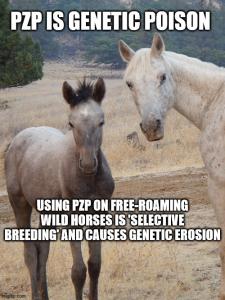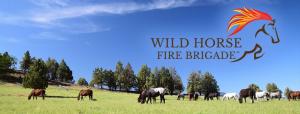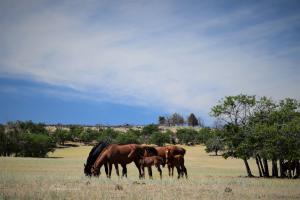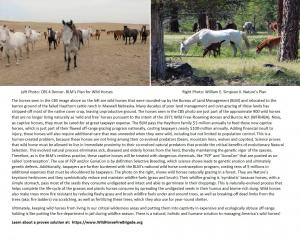
Selloff In Livestock Industry Presents New Challenges For Remaining American Wild Horses

Shooting free-roaming American wild horses with PZP is 'harassment' and a violation of the federal Act to protect wild horses. Using PZP is 'selective breeding' and causes social disruption in family-bands and leads to genetic erosion.
Growing drought conditions coupled with high feed costs are forcing many cattle and sheep producers out of business who are selling their entire herds
It's critically important to understand that in America today, there are basically two kinds of livestock producers based upon how they fatten their livestock for the market.
The first kind of livestock producer - the farmer-rancher:
The first kind of ranchers are also farmers. They are producers who grow the feed they use to fatten cattle and sheep themselves. Many ranchers are grass farmers who farm hundreds and thousands of acres in order to have the feed for their livestock. These farmer-ranchers don't buy government grazing permits.
These rancher-farmers are highly dependent upon water resources and good weather for their agricultural production, which in turn supplies the feed needed to fatten their cattle and sheep. And even in good times, cheap beef and sheep imported into America from Brazil and elsewhere creates tough competition for farmer-ranchers whose agri-production costs made profit margins thin for their cattle and sheep.
The now longstanding changes in weather and resulting ongoing widespread drought is putting these farmer-rancher livestock producers out of business, even with government subsidy payments.
The evidence is compelling. For the first time in history, we are seeing farmer-ranchers selling off their entire herds, including vital breeding stock. This means the end of business for these producers.
Numerous news providers started carrying stories of the selloffs of ranches and entire herds of livestock back in 2022.
And this now widespread selloff is not just limited to the most drought stricken states. Farmer-ranchers in Kansas, Oklahoma and other states are getting out of business, which will create huge shortages in livestock based products that must be filled given that 97% of Americans consume livestock products.
The second kind of livestock producers - Ranchers who graze livestock on public lands.
The second kind of rancher does not grow feed for their herds of cattle and sheep. Instead, they buy grazing rights from the Bureau of Land Management and the U.S. Forest Service on public lands. And the price is right at just $1.35
According to High County News:
"The Bureau of Land Management and Forest Service announced federal grazing fees for 2022: Just $1.35"
"Grazing fees dictate how much ranchers pay for each “animal unit” — one cow and calf, one horse or five sheep — per month. This year’s fee — just $1.35 per animal unit — keeps the grazing costs at the same rate since 2019, when Trump’s BLM lowered the fee from $1.41."
Clearly, the financial risks from climate change and the impacts on agricultural producers of livestock feeds is eliminated for ranchers who instead of growing feed for livestock, graze public lands, and do so quit cheaply.
So what does all this mean for free roaming wild horses on public lands commingled with livestock?
American wild horses are facing their toughest challenge ever, a massive increase in demand for cheap grazing.
The economic pressures to remove even more wild horses from public grazing lands will increase greatly in order to make room for more livestock to make up for the loss of livestock producers going out of business by selling-off their entire herds.
It's abundantly clear that wild horses are now in the gravest jeopardy ever. And the people who are promoting the use of chemical sterilization via 'PZP', also known as 'fertility control', are not going to prevent roundups.
The elephant in the room is that the BLM and the livestock industry will want to remove as many non-commercial herbivores from the public grazing lands as possible. So contrary to what PZP promoters argue, even sterilized horses need to eat and are seen as unwanted and unwelcome competition for grazing resources.
What can be done to save America's iconic wild horse?
There are people who are promoting policies (using chemical sterilization) to manage wild horses who are literally road-blocking the only genuine solution for giving American wild horses the natural freedom they rightly deserve.
But why would anyone who cares about wild horses want to road-block a great solution to actually allow wild horses to live naturally wild and free? Money is the short answer. Some of the wild horse nonprofit heads are paid very handsomely! And a solution that ends the plight of wild horses also ends their financial income.
The genuine solution is simple, but it has an adverse impact on nonprofit organizations who make money (donations) by promoting PZP as their solution.
American Wild Horse Campaign is just one of many nonprofits who have jumped on the profitable PZP bandwagon. And a genuine solution would adversely impact their donation revenue stream.
Lets face it, if all the wild horses suddenly had a place to live wild and free beyond conflicts with the grazing and other public land use stakeholders, American Wild Horse Campaign and other PZP promoters would all need to find new jobs.
And using PZP on wild horses has many serious side-effects that are injurious to wild horses and their sustainable natural conservation, as we read in this Press Release: https://www.einnews.com/pr_news/607372689/costly-wild-horse-management-exposing-the-crutches-of-a-failed-paradigm-killing-american-wild-horses
The only genuine solution to provide sustainable natural conservation of American wild horses is a plan called the 'Natural Wildfire Abatement and Forest Protection Plan', also known as 'Wild Horse Fire Brigade'.
Wild Horse Fire Brigade can keep American wild horses in remote critical wilderness areas that are off-limits to motorized vehicles and equipment as well as livestock grazing. There is approximately 110-million acres of Critical Wilderness, mostly in the Pacific Northwest, where there is ample water and natural grazing.
Wild Horse Fire Brigade can keep wild horses living naturally wild and free.
Learn more about this Plan, support it, and share it.
William E. Simpson II
Wild Horse Fire Brigade
+1 858-212-5762
email us here
Visit us on social media:
Facebook
Twitter
YouTube
Other
More Wild Horses Equals Less Wildfire Fuels
EIN Presswire does not exercise editorial control over third-party content provided, uploaded, published, or distributed by users of EIN Presswire. We are a distributor, not a publisher, of 3rd party content. Such content may contain the views, opinions, statements, offers, and other material of the respective users, suppliers, participants, or authors.





